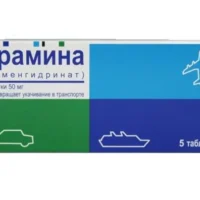Description
Dramina (Dimenhydrinate) Tablets 50 mg. №10
Ingredients:
Each tablet contains 50 mg of dimenhydrinate.
Mechanism of Action:
Dimenhydrinate, an antihistamine, exerts its pharmacological effects by blocking histamine receptors in the brain. By doing so, it inhibits the transmission of signals that induce nausea and vomiting, particularly in cases of motion sickness and vertigo.
Pharmacological Properties:
Dimenhydrinate possesses antiemetic properties due to its ability to antagonize histamine receptors in the central nervous system, thereby alleviating symptoms of nausea and vertigo.
Indications for Use:
Dramina tablets are indicated for the prevention and treatment of motion sickness, vertigo, and nausea in both adults and children over 12 years old.
Contraindications:
Avoid using Dramina if you have a known allergy to dimenhydrinate or any other components present in the tablets. Consult a healthcare professional for suitable alternatives.
Side Effects:
Common side effects of Dramina may include drowsiness, dry mouth, and blurred vision. It is recommended to refrain from driving or operating heavy machinery while under the influence of this medication. Pregnant or breastfeeding individuals should seek medical advice before initiating treatment.
Usage Instructions:
For adults and children over 12 years old, the typical dosage involves taking 1-2 tablets every 4-6 hours, as required. Swallow the tablets whole with water; avoid crushing or chewing them.
Benefits Compared to Analogues:
Dramina stands out from its analogues due to its proven efficacy in managing motion sickness and vertigo symptoms, supported by clinical evidence. Its well-established safety profile further distinguishes it as a reliable choice for individuals seeking relief from these conditions.
Suitable Patient Groups:
Dramina is suitable for use in both adults and children over 12 years old. However, specific dosing adjustments may be necessary for elderly patients or individuals with underlying medical conditions. Consult a healthcare provider for personalized recommendations.
Storage Conditions and Shelf Life:
Store Dramina tablets in a cool, dry place away from direct sunlight. Adhere to the recommended storage temperature range provided on the packaging. Check the expiry date before use and discard any expired tablets appropriately.
Packaging Description:
Dramina tablets are typically packaged in blister packs containing 10 tablets each. The packaging should include essential information such as the product name, dosage strength, ingredients, usage instructions, and expiry date.
Clinical Evidence and Proven Effectiveness:
Dimenhydrinate, the active ingredient in Dramina, has been extensively studied for its efficacy in managing motion sickness and vertigo. Clinical trials have consistently demonstrated the positive impact of dimenhydrinate in alleviating symptoms and improving patient outcomes. Its mechanism of action and safety profile make it a preferred choice in clinical practice.





